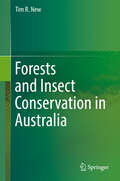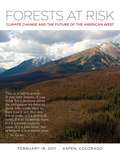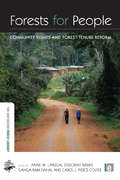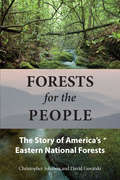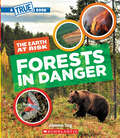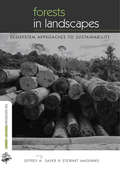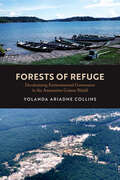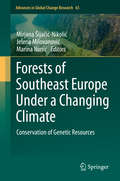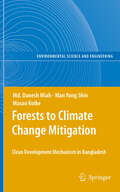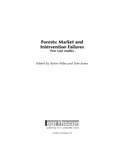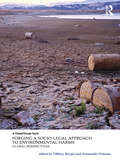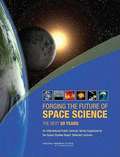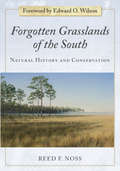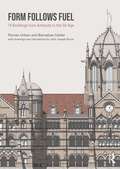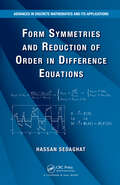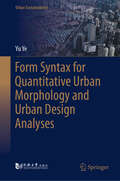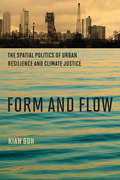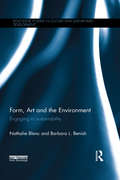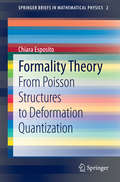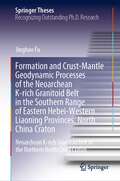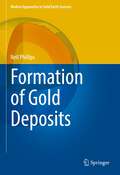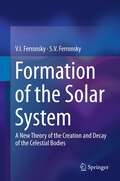- Table View
- List View
Forests and Global Change
by David A. Coomes David F. R. P. Burslem William D. Simonson David A. Coomes David F. R. P. Burslem William D. SimonsonForests hold a significant proportion of global biodiversity and terrestrial carbon stocks and are at the forefront of human-induced global change. The dynamics and distribution of forest vegetation determines the habitat for other organisms, and regulates the delivery of ecosystem services, including carbon storage. Presenting recent research across temperate and tropical ecosystems, this volume synthesises the numerous ways that forests are responding to global change and includes perspectives on: • the role of forests in the global carbon and energy budgets • historical patterns of forest change and diversification • contemporary mechanisms of community assembly and implications of underlying drivers of global change • the ways in which forests supply ecosystem services that support human lives. The chapters represent case studies drawn from the authors' expertise, highlighting exciting new research and providing information that will be valuable to academics, students, researchers and practitioners with an interest in this field.
Forests and Insect Conservation in Australia
by Tim R. NewLosses of forests and their insect inhabitants are a major global conservation concern, spanning tropical and temperate forest regions throughout the world. This broad overview of Australian forest insect conservation draws on studies from many places to demonstrate the diversity and vulnerability of forest insects and how their conservation may be pursued through combinations of increased understanding, forest protection and silvicultural management in both natural and plantation forests. The relatively recent history of severe human disturbance to Australian forests ensures that reasonably natural forest patches remain and serve as ‘models’ for many forest categories. They are also refuges for many forest biota extirpated from the wider landscapes as forests are lost, and merit strenuous protection from further changes, and wider efforts to promote connectivity between otherwise isolated remnant patches. In parallel, the recent attention to improving forest insect conservation in harmony with insect pest management continues to benefit from perspectives generated from better-documented faunas elsewhere. Lessons from the northern hemisphere, in particular, have led to revelations of the ecological importance and vulnerability of many insect taxa in forests, together with clear evidence that ‘conservation can work’ in concert with wider forest uses. A brief outline of the variety of Australian tropical and temperate forests and woodlands, and of the multitude of endemic and, often, highly localised insects that depend on them highlights needs for conservation (both of single focal species and wider forest-dependent radiations and assemblages). The ways in which insects contribute to sustained ecological integrity of these complex ecosystems provide numerous opportunities for practical conservation.
Forests at Risk: Climate Change and the Future of the American West
by Aspen Center for Environmental StudiesClimate change poses a huge threat to the West. The currmountain pine beetle epidemic with over 50 million acres of dying trees in western North America has created a powerful “teachable moment” across the region. A primary goal of the Forests At Risk symposium was to reframe the nation’s climate change dialogue by making the issue both personal and real to many who may not appreciate its connection to the immediate world around them. While some may have difficulty relating to rising sea levels, falling water tables, imperiled polar bears and melting glaciers in far-off places, they are still shocked by the sight of vast dying forests around their homes. The Forests At Risk symposium explored the statemby Andy Jacobson, a carbon cycle scientist at the National Oceanic and Atmospheric Administration in Boulder, that “this is the kind of feedback we're all very worried about in the carbon cycle ... a warming planet leading to, in this case, an insect outbreak that increases carbon dioxide into the atmosphere, which can increase warming.” The overwhelming scientific consensus holds that climate change is one of the mserious threats facing humankind today. We have a soberingly short time in which to reduce atmospheric greenhouse gases if we are to preserve our quality of life and environment. In addition to the global urgency, the American West is deeply dependon the health of its forests, mountains and streams for both its quality of life and its economy. Put simply, if global warming shortens our winters, diminishes our recreation, and unleashes wildfires, diseases and insect epidemics that devastate our forests, the regional damage would be incalculable. NOW is the perfect time to learn more in this ebook. The Forests At Risk symposium represented the first substantial public forum focused directly on the connection between climate change and forest health in the American West. In the wake of millions of acres of pine beetle devastation across our continent, this is the ideal momto highlight the climate change connection and focus on the question of what happens when our forests transform from carbon sinks into carbon sources.
Forests for People: Community Rights and Forest Tenure Reform
by Deborah Barry Anne M Larson Ganga Ram DahalWho has rights to forests and forest resources? In recent years governments in the South have transferred at least 200 million hectares of forests to communities living in and around them . This book assesses the experience of what appears to be a new international trend that has substantially increased the share of the world's forests under community administration. Based on research in over 30 communities in selected countries in Asia (India, Nepal, Philippines, Laos, Indonesia), Africa (Burkina Faso, Cameroon, Ghana) and Latin America (Bolivia, Brazil, Guatemala, Nicaragua), it examines the process and outcomes of granting new rights, assessing a variety of governance issues in implementation, access to forest products and markets and outcomes for people and forests . Forest tenure reforms have been highly varied, ranging from the titling of indigenous territories to the granting of small land areas for forest regeneration or the right to a share in timber revenues. While in many cases these rights have been significant, new statutory rights do not automatically result in rights in practice, and a variety of institutional weaknesses and policy distortions have limited the impacts of change. Through the comparison of selected cases, the chapters explore the nature of forest reform, the extent and meaning of rights transferred or recognized, and the role of authority and citizens' networks in forest governance. They also assess opportunities and obstacles associated with government regulations and markets for forest products and the effects across the cases on livelihoods, forest condition and equity. Published with CIFOR
Forests for the People: The Story of America's Eastern National Forests
by Christopher Johnson David GovatskiAt the turn of the twentieth century, widespread clearcutting resulted in ecological ruin and devastating fires in America's Eastern forests. A coalition of citizens, organizations, and business and political leaders fought against this pattern, and in 1911, they achieved a landmark victory with the Weeks Act, which protected millions of acres of Eastern forests. Forests for the People tells the fascinating story of this vital legislation and the citizens and organizations that made it a reality. While these protected forests survive today, many of the critical issues facing American forests in the twentieth century persist, and new threats have arisen--including oil shale drilling, invasive species, and development around national parks. In Forests for the People, Christopher Johnson and David Govatski draw upon the lessons and victories of the past to examine the vital issues facing American forests today and illuminate paths to better forest management.
Forests in Danger (A True Book (Relaunch))
by Jasmine TingDiscover the rich biodiversity of Earth's biomes - and how they might be saved - with this STEAM-based subset of True Books.Did you know that forests contain many plant and animal species that are still unknown to science? This leafy biome is also a key to slowing climate change! Get ready to investigate Earth's wildly diverse forest ecosystems, as well as the plants and animals that have adapted to survive in them. You'll also learn about the many threats facing this fascinating biome - and what each of us can do to help - all in the pages of Forests in Danger.ABOUT THE SERIES:There are five major biomes on Earth: desert, forest, grassland, aquatic, and tundra. These rich, wild places are home to a wide variety of plants and animals - many of which are found nowhere else. Unfortunately, these ecosystems have been put at risk by human activities. This STEAM-based set of True Books introduces students to the incredible biodiversity of Earth's amazing biomes, as well as the threats they face in the era of climate change. Interesting information is presented in a fun, friendly way - and in the simplest terms possible - and will inspire kids to think about how they can help stop the destruction of Earth's wild spaces.
Forests in Landscapes: Ecosystem Approaches to Sustainability (The\earthscan Forest Library)
by Jeffrey Sayer�At last a really useful book telling us how all the rhetoric about ecosystem approaches and sustainable forest management is being translated into practical solutions on the ground� CLAUDE MARTIN, WWF INTERNATIONAL �For too long, foresters have seen forests as logs waiting to be turned into something useful. This book demonstrates that forests in fact have multiple values, and managing them as ecosystems will bring more benefits to a greater cross-section of the public� JEFFREY A. MCNEELY, CHIEF SCIENTIST, IUCN �This book demonstrates that [ecosystem approaches and sustainable forest management] are neither alternative methods of forest management nor are they simply complicated ways of saying the same thing. They are both emerging concepts for more integrated and holistic ways of managing forests within larger landscapes in ways that optimize benefits to all stakeholders� ACHIM STEINER AND IAN JOHNSON, FROM THE FOREWORD Recent innovations in Sustainable Forest Management and Ecosystem Approaches are resulting in forests increasingly being managed as part of the broader social-ecological systems in which they exist. Forests in Landscapes reviews changes that have occurred in forest management in recent decades. Case studies from Europe, Canada, the United States, Russia, Australia, the Congo and Central America provide a wealth of international examples of innovative practices. Cross-cutting chapters examine the political ecology and economics of forest management, and review the information needs and the use and misuse of criteria and indicators to achieve broad societal goals for forests. A concluding chapter draws out the key lessons of changes in forest management in recent decades and sets out some thoughts for the future. This book is a must-read for practitioners, researchers and policy makers concerned with forests and land use. It contains lessons for all those concerned with forests as sources of people's livelihoods and as part of rural landscapes. Published with IUCN and PROFOR
Forests of Refuge: Decolonizing Environmental Governance in the Amazonian Guiana Shield
by Dr. Yolanda Ariadne CollinsForests of Refuge questions the effectiveness of market-based policies that govern forests in the interest of mitigating climate change. Yolanda Ariadne Collins interrogates the most ambitious global plan to incentivize people away from deforesting activities: the United Nations–endorsed Reducing Emissions from Deforestation and Forest Degradation (REDD+) initiative. Forests of Refuge explores REDD+ in Guyana and neighboring Suriname, two highly forested countries in the Amazonian Guiana Shield with low deforestation rates. Yet REDD+ implementation there has been fraught with challenges. Adopting a multisited ethnographic approach, Forests of Refuge takes readers into the halls of policymaking, into conservation development organizations, and into forest-dependent communities most affected by environmental policies and exploitative colonial histories. This book situates these challenges in the inattentiveness of global environmental policies to roughly five hundred years of colonial histories that positioned the forests as places of refuge and resistance. It advocates that the fruits of these oppressive histories be reckoned with through processes of decolonization.
Forests of Southeast Europe Under a Changing Climate: Conservation of Genetic Resources (Advances in Global Change Research #65)
by Mirjana Šijačić-Nikolić Jelena Milovanović Marina NonićThis book integrates the different prospective, scientific and practical experience of researchers as well as beneficiaries and stakeholders in the field of forest conservation in Southeast Europe. The book stresses the importance of improving the adaptability of these ecosystems to the impacts of climate change. Gathered around a common idea, the book presents the latest results in forest genetic resources conservation at national and regional level. The chapters are written by experts from: Bosnia and Herzegovina, Bulgaria, Croatia, FYR Macedonia, Greece, Montenegro, Romania, Serbia and Slovenia. The book presents the current state, legal and institutional framework for conservation and management of forest genetic resources, case studies and best practices in the application of different conservation methods and techniques (in situ and ex situ) as well as climate change aspects in this area. This book will be of particular interest to scientists and experts in the field of forestry, environmental protection and rural development, bachelor, master and doctoral students, as well as for anyone interested in the conservation issues fuelled by ethical and economic motives.
Forests to Climate Change Mitigation
by Man Yong Shin Masao Koike Md. Danesh MiahToday, the effect of global climate change is clear to all. It is clearly dangerous in developing countries such as Bangladesh. The industrial revolution caused major changes in technology, socio-economy and cultures in the late 18th and early 19th century, beginning in Britain and spreading throughout the world. The technology dominated economy was mostly dependent on energy produced from fossil fuel, which still holds true today. It is well known that fossil fuel burning has increased the GHGs to the atmosphere, thus creating global warming. Among the GHGs, the concentration of CO2 has been confirmed as the largest. Terrestrial ecosystems are clearly influencing the concentration of GHGs in the atmosphere. Greenhouse gases are constantly entering and leaving the atmosphere. Actively growing trees and other plants absorb CO2 from the atmosphere, combine it with water through photosynthesis and create sugars and more stable carbohydrates. Through this process, trees capture and store atmospheric CO2 in vegetation, soils and biomass products. The Kyoto Protocol, in 1997, explored a flexible mechanism, CDM (Clean Development Mechanism) where Annex I and non-Annex I parties interact for climate change mitigation. Forestry activities have been considered important in the arena of climate change as they act both as a sink and sources of carbon. The purpose of this book is to highlight the means of efficiently reducing global warming through forestry options in Bangladesh and the positive implications of CDM.
Forests: Five case studies (Environmental and Resource Economics Set)
by Tom Jones Soren WibeThe economic value of forest. has long been recognized, but the ways in which that value is calculated and the management policies adopted in consequence have all too often resulted in overuse and irreversible destruction. This is spectacularly obvious around the Mediterranean basin, but it is also true in northern Europe. These five case studies, commissioned by the OECD, examine failures of forest management in Britain, Spain, Italy, Germany and Sweden. They look at both market and intervention policies and show how each can further the destruction of the forests, and they set out ways in which future policies can evade the mistakes of the past. Originally published in 1992
Forging a Socio-Legal Approach to Environmental Harms: Global Perspectives (Law, Justice and Ecology)
by Tiffany Bergin Emanuela OrlandoEnvironmental harms exert a significant toll and pose substantial economic costs on societies around the world. Although such harms have been studied from both legal and social science perspectives, these disciplinary-specific approaches are not, on their own, fully able to address the complexity of these environmental challenges. Many legal approaches, for example, are limited by their inattention to the motivations behind environmental offences, whereas many social science approaches are hindered by an insufficient grounding in current legislative frameworks. This edited collection constitutes a pioneering attempt to overcome these limitations by uniting legal and social science perspectives. Together, the book’s contributors forge an innovative socio-legal approach to more effectively respond to, and to prevent, environmental harms around the world. Integrating theoretical and empirical work, the book presents carefully selected illustrations of how legal and social science scholarship can be brought together to improve policies. The various chapters examine how a socio-legal approach can ultimately lead to a more comprehensive understanding of environmental harms, as well as to innovative and effective responses to such environmental offences.
Forging the Future of Space Science: The Next 50 Years
by National Research Council of the National AcademiesFrom September 2007 to June 2008 the Space Studies Board conducted an international public seminar series, with each monthly talk highlighting a different topic in space and Earth science. The principal lectures from the series are compiled in Forging the Future of Space Science. The topics of these events covered the full spectrum of space and Earth science research, from global climate change, to the cosmic origins of life, to the exploration of the Moon and Mars, to the scientific research required to support human spaceflight. The prevailing messages throughout the seminar series as demonstrated by the lectures in this book are how much we have accomplished over the past 50 years, how profound are our discoveries, how much contributions from the space program affect our daily lives, and yet how much remains to be done. The age of discovery in space and Earth science is just beginning. Opportunities abound that will forever alter our destiny.
Forgotten Grasslands of the South: Natural History and Conservation
by Reed F NossForgotten Grasslands of the South is the study of one of the biologically richest and most endangered ecosystems in North America. In a seamless blend of science and personal observation, renowned ecologist Reed Noss explains the natural history of southern grasslands, their origin and history, and the physical determinants of grassland distribution, including ecology, soils, landform, and hydrology. In addition to offering fascinating new information about these little-studied ecosystems, Noss demonstrates how natural history is central to the practice of conservation. Although theory and experimentation have recently dominated the field of ecology, ecologists are coming to realize how these distinct approaches are not divergent but complementary, and that pursuing them together can bring greater knowledge and understanding of how the natural world works and how we can best conserve it. This long-awaited work sets a new standard for scientific literature and is essential reading for those who study and work to conserve the grasslands of the South as well as for everyone who is fascinated by the natural world.
Forgotten: Searching for Palestine’s Hidden Places and Lost Memorials
by Raja Shehadeh Penny JohnsonForgotten is a search for hidden or neglected memorials and places in historic Palestine - now Israel and the Occupied Palestinian Territories - and what they might tell us about the land and the people who live on our small slip of earth between the Mediterranean Sea and the Jordan River.From ancient city ruins to the Nabi 'Ukkasha mosque and tomb, acclaimed writers and researchers Raja Shehadeh and Penny Johnson ask: what has been memorialised, and what lies unseen, abandoned or erased - and why? Whether standing on a high cliff overlooking Lebanon or at the lowest land-based elevation on earth at the Dead Sea, they explore lost connections in a fragmented land.In elegiac, elegant prose, Shehadeh and Johnson grapple not only with questions of Israeli resistance to acknowledging the Nakba - the 1948 catastrophe for Palestinians - but also with the complicated history of Palestinian commemoration today.
Form Follows Fuel: 14 Buildings from Antiquity to the Oil Age
by Barnabas Calder Florian UrbanModernists believed that “form follows function.” Form Follows Fuel shows that in fact energy has been the biggest influence on the world’s architecture throughout the history of our species. The availability of energy under different fuel regimes – including human labour, firewood, coal, oil, gas, and renewables – shapes architecture at all scales, from what gets built to how its doors hinge.This book is the first to quantify energy inputs for a range of buildings worldwide and across the historical record. In the process, it challenges today's architects, offers practical solutions to today's ecological crises, and highlights the aspects of today’s buildings that make architecture responsible for 37% of human climate-changing emissions. It reveals the enormously lower impacts of historical alternatives to today’s default building practices.This book shows that the shift to modern fossil fuel use, from the seventeenth century, came to be the most consequential move in the history of architecture as well as in human history in general. This brought about remarkable wealth for the built environment and at the same time unprecedented dangers for our planet, as evidenced by the exacerbating climate emergency.This book consists of 14 accessibly written case studies, illustrated with beautiful and revealing new measured drawings of each project by John Joseph Burns. Each chapter focuses on a single structure in a particular historical context, sometimes contrasted to similar buildings, from subsistence farming to advanced global capitalism. The chapters analyse the consumption of embodied and operational energy in these buildings, and also discuss questions of recycling and adaptive reuse. They complement precise descriptions with hard numbers on materials and construction, using robustly sourced approximations where exact figures are not available. The case studies rely on both published research and the authors’ own calculations and allow systematic comparison across different global regions and historical periods.Cases include architectural icons such as the Great Pyramid of Giza, the Baths of Caracalla, the Mausoleum of Qin Shi Huang, the Seagram Building, and Terminal 1 of Kuala Lumpur International Airport, as well as common types such as a pre-modern stone house, a late-nineteenth-century tenement, and a modernist panel block. Examples are taken from different regions of the world, including ancient China, pre-Columbian Mexico, and modern Europe. This book is an important contribution to architectural historical research, written for students, academics and building professionals as well as for a general audience.
Form Symmetries and Reduction of Order in Difference Equations (Advances in Discrete Mathematics and Applications)
by Hassan SedaghatForm Symmetries and Reduction of Order in Difference Equations presents a new approach to the formulation and analysis of difference equations in which the underlying space is typically an algebraic group. In some problems and applications, an additional algebraic or topological structure is assumed in order to define equations and obtain significa
Form Syntax for Quantitative Urban Morphology and Urban Design Analyses (Urban Sustainability)
by Yu YeThis book sets out to develop a quantitative-based analysis, Form Syntax, which is able to identify various prototypes of urban forms and their degrees of urbanity, thereby enhancing urban design practices. Form Syntax is a combination of emerging quantitative analysis tools with qualitative urban morphology tradition. It integrates a set of spatial analysis tools including Space Syntax, Spacematrix, and Mixed-use index (MXI) through GIS to measure the morphological features of streets, buildings and blocks, and functions. Furthermore, the Form Syntax assists in comprehending the intrinsic, evolving logic of urban form. Based on the findings of urban morphology, the Urban Form Index could function as an analytical instrument in numerous phases of the urban design process, thereby promoting urban vitality. Moreover, morphology-led understandings of urban design theory can inform urban design practices. This study endeavors to introduce quantitative thinking into urban morphology and urban design, with the objective of developing a lively built environment and pursuing more vibrant place-making.
Form and Flow: The Spatial Politics of Urban Resilience and Climate Justice (Urban and Industrial Environments)
by Kian GohAn examination of urban climate change response strategies and the resistance to them by grassroots activists and social movements.Cities around the world are formulating plans to respond to climate change and adapt to its impact. Often, marginalized urban residents resist these plans, offering &“counterplans&” to protest unjust and exclusionary actions. In this book, Kian Goh examines climate change response strategies in three cities—New York, Jakarta, and Rotterdam—and the mobilization of community groups to fight the perceived injustices and oversights of these plans. Looking through the lenses of urban design and socioecological spatial politics, Goh reveals how contested visions of the future city are produced and gain power. Goh describes, on the one hand, a growing global network of urban environmental planning organizations intertwined with capitalist urban development, and, on the other, social movements that themselves often harness the power of networks. She explores such initiatives as Rebuild By Design in New York, the Giant Sea Wall plan in Jakarta, and Rotterdam Climate Proof, and discovers competing narratives, including community resiliency in Brooklyn and grassroots activism in the informal &“kampungs&” of Jakarta. Drawing on participatory fieldwork and her own background in architecture and urban design, Goh offers both theoretical explanations and practical planning and design strategies. She reframes the critical concerns of urban climate change responses, presenting a sociospatial typology of urban adaptation and considering the notion of a &“just&” resilience. Finally, she proposes a theoretical framework for designing equitable and just urban climate futures.
Form, Art and the Environment: Engaging in Sustainability (Routledge Studies in Culture and Sustainable Development)
by Nathalie Blanc Barbara L. BenishForm, Art and the Environment: Engaging in Sustainability adopts a pluralistic perspective of environmental artistic processes in order to examine the contributions of the arts in promoting sustainable development and culture at a grassroots level and its potential as a catalyst for social change and awareness. This book investigates how community arts, environmental creativity, and the changing role of artists in the Polis contribute to the goal of a sustainable future from a number of interdisciplinary perspectives. From considering the role that art works play in revealing local environmental problems such as biodiversity, public transportation and energy issues, to examining the way in which artists and art works enrich our multidimensional understanding of culture and sustainable development, Form, Art and the Environment advocates the inestimable value of art as an expressive force in promoting sustainable culture and conscious development. Utilising a broad range of case studies and analysis from a body of work collected through the international environmental COAL prize, this book examines the evolution of the relationship between culture and the environment. This book will be of interest to practitioners of the environmental arts, culture and sustainable development and students of Art, Environmental Science, and International Policy and Planning Development.
Formal Peace and Informal War: Security and Development in Congo (Routledge Explorations in Development Studies)
by Zoë MarriageNorthern interventions into African countries at war are dominated by security concerns, bolstered by claims of shared returns and reinforcing processes of development and security. As global security and human security became prominent in development policy, Congo was wracked by violent rule, pillage, internal fighting, and invasion. In 2002, the Global and All-Inclusive Peace was promoted by northern donors, placing a formal peace on the mass of informalised wars. Formal Peace and Informal War: Security and Development in Congo examines how the security interests of the Congolese population have interacted with those of northern donors. It explores Congo’s contemporary wars and the peace agreed on in 2002 from a security perspective and challenges the asserted commonality of the liberal interventions made by northern donors. It finds that the peace framed the multiple conflicts in Congo as a civil war and engineered a power-sharing agreement between elite belligerents. The book argues that the population were politically and economically excluded from the peace and have been subjected to control and containment when their security rests with power and freedom.
Formality Theory
by Chiara EspositoThis book is a survey of the theory of formal deformation quantization of Poisson manifolds, in the formalism developed by Kontsevich. It is intended as an educational introduction for mathematical physicists who are dealing with the subject for the first time. The main topics covered are the theory of Poisson manifolds, star products and their classification, deformations of associative algebras and the formality theorem. Readers will also be familiarized with the relevant physical motivations underlying the purely mathematical construction.
Formation and Crust-Mantle Geodynamic Processes of the Neoarchean K-rich Granitoid Belt in the Southern Range of Eastern Hebei-Western Liaoning Provinces, North China Craton: Neoarchean K-rich Granitoid Belt in the Northern North China Craton (Springer Theses)
by Jinghao FuMeso- to Neoarchean is a critical transitional period for the formation and evolution of continental crust and the corresponding geodynamic mechanisms, during which the average composition of continental crust gradually shifted from Na-enriched to K-enriched. However, the ultimate source of K and its enrichment mechanism in continental crust are still enigmatic. Moreover, fierce controversies remain on the Precambrian subdivision and late Archean geodynamic models of the North China Craton (NCC). Archean basement terranes in the Eastern Hebei-Western Liaoning Provinces, northern NCC display characteristic lithological zonation similar to those developed in modern convergent plate margins, and from northwest to southeast can be subdivided into the MORB-type tholeiite belt, oceanic arc tectonic belt, and K-rich granitoid belt. This book reports systematic field geological, petrographic, structural, whole-rock geochemical, and zircon U-Pb-Hf-O isotopic data for the various late Neoarchean lithological assemblages of the K-rich granitoid belt. Their deformational characteristics and petrogenesis are discussed in detail, and integrated with their spatiotemporal relationships and metamorphic features, a late Neoarchean active continental margin setting with multi-stage trench retreats and subsequent arc-continent collision is proposed to account for the formation and evolution of the K-rich granitoid belt. It also throws light upon the ultimate source and enrichment mechanism of K in the late Archean continental crust by comparing K-rich granitoid belt with the adjacent oceanic arc tectonic belt.
Formation of Gold Deposits (Modern Approaches in Solid Earth Sciences #21)
by Neil PhillipsThis book addresses the origin of gold deposits to answer questions of science and curiosity. These answers contribute in turn to the improved exploration and mining of gold. Initially there is a summary of the methods used to address the genesis of gold deposits including some of the essential science and concepts. Five basic observations follow that apply to many gold deposits and need to be considered in any genetic ideas. Magmatic processes enriching gold are discussed followed by the role of aqueous fluids during gold deposit formation at elevated temperatures and pressures. Modifying effects after deposit formation include high-grade metamorphism, retrogression, weathering, and erosion. The main types of gold deposits are then explained within the spectrum of viable genetic ideas, with informal names for these examples that include gold-only, gold-plus, Carlin, slate-belt, epithermal, porphyry, iron oxide copper gold, and Archean greenstone. Case histories are included in which the role of gold geology contributed directly to discoveries—one example is at the province-scale and another at the goldfield-scale. Unlike other books on the subject, this one addresses virtually all gold deposit types rather than focusing on one type in isolation. The primary readership includes industry geologists, senior undergraduates, postgraduates, and those with some knowledge of science and an interest in the gold industry.
Formation of the Solar System
by S. V. Ferronsky V. I. FerronskyAnalysis of the orbital motion of the Earth, the Moon and other planets and their satellites led to the discovery that all bodies in the Solar System are moving with the first cosmic velocity of their proto parents. The mean orbital velocity of each planet is equal to the first cosmic velocity of the Protosun, the radius of which is equal to the semi-major axis of the planet's orbit. The same applies for the planets' satellites. All the small planets, comets, other bodies and the Sun itself follow this law, a finding that has also been proven by astronomical observations. The theoretical solutions based on the Jacobi dynamics explain the process of the system creation and decay, as well as the nature of Kepler's laws.

